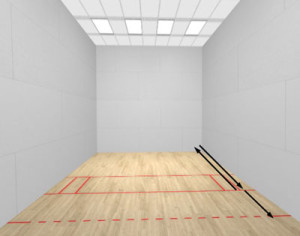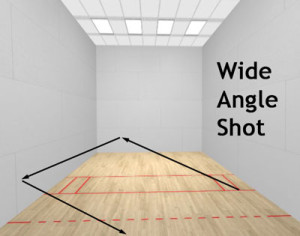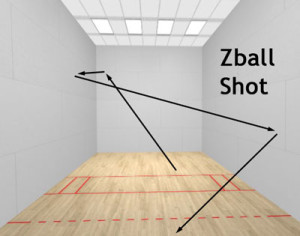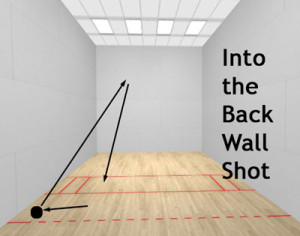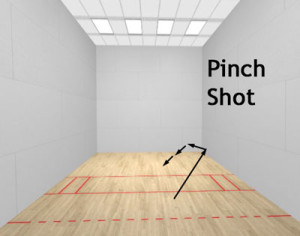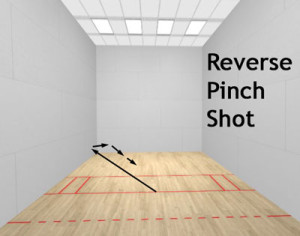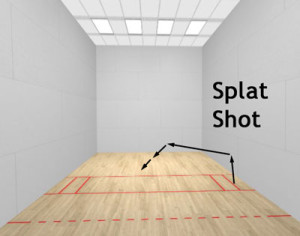Racquetball Shots
Racquetball shots can generally be split into two categories: passing shots and kill shots. Passing shots, as the name implies, are used to pass your opponent so that she is forced to move out of good position. Depending on how they are hit and the location of your opponent, passing shots can be both defensive and offensive. Kill shots are used to end the rally and are considered offensive shots. In this article I’m going to describe the shots themselves, but I’m going to save shot selection and strategy for another time, since that is a big topic in itself.
Racquetball Passing Shots
Ceiling Shot
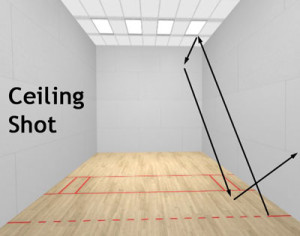
In a ceiling shot the ball hits the ceiling first. Then the front wall. Then the floor close to the serve box. And then after taking a high bounce it should ideally hit the crack between the wall and floor and “die.” Of course it is extremely difficult to get the ball to do just that on the last bounce. But you should aim to have the ball either land a foot away from the back wall or a foot high on the back wall itself. If the ball hits the back wall at anything above a foot from the floor, you are setting up your opponent for an offensive shot. To execute the ceiling shot, you should aim at the ceiling just a few feet from the back wall. A lot of courts position ceiling lights right around there. So you can use those as a point of reference for where to aim. You need to experiment with how hard to hit it to make sure it does not come off the back wall too high. You would generally want to practice using less force than you think you need because you will hit harder during a rally due to adrenaline and speed of the game. You can hit ceiling balls down the line or cross court, just like the regular passing shots I will describe next.
Down the Line Shot
Down the line is a shot that goes directly toward the front wall and bounces back parallel to the side wall. It’s one of the most common and effective shots in racquetball. It should generally be hit when you are 4-6 feet away from a side wall and you should aim it 1-2 feet above the floor. You shouldn’t try to hit the ball too close to a side-wall because there’s a good chance of hitting that side-wall and forcing the ball to pop-out to center court. That would produce an easy set up for your opponent.
Cross Court Shot
Cross Court is shot toward the center of the front wall, when you are positioned close to a side wall. The aim is to have the ball bounce once in the center court and have the 2nd bounce very close to the corner opposite to you. The racquet is angled toward the center of the front wall so that the ball is propelled across the court. You want to hit the ball toward the front of your stance (rather than in the middle, as for the down the line shot).
Wide Angle Shot
Wide Angle shot is similar to cross court. Except rather than aiming close to the center of the front wall, you aim at a point that is a foot or so away from the side wall opposite to you. After the ball rebounds off the front wall, you want it to hit the side wall somewhere by the dotted line and go to the middle of the court toward the back wall.
Z-Ball Shot
Z-ball shot is similar to Z drive serve. The ball hits high on the front wall close to a corner, then a side wall, then the other side wall (without first touching the floor or ceiling or back wall), and then because of the spin rebounds almost parallel to the back wall. Hitting 3 walls like this is illegal during a serve, but perfectly legal during a rally. If executed properly, it can be a very effective shot, since it’s so hard to return due to the spin placed on it by contacting so many surfaces. Still, this shot should rarely be attempted and only in desperate situations when other more traditional shots are difficult to execute.
Into the Back Wall Shot
Just as it sounds, you hit this shot directly into the back wall with enough power and at such an angle that the ball is capable of flying across the court and hitting the front wall. This is a very defensive shot and should really be used as a last resort when you feel it’s impossible to hit the ball as it comes off the back wall. But sometimes there’s just no other option and it’s worth it to hit this shot to keep the rally going. Understand that you’ll probably provide a good set up to your opponent by doing this, since it’s extremely difficult to control this shot.
Racquetball Kill Shots
Kill shot is any racquetball shot that is hit so low that it bounces twice right near the front wall and is simply impossible for the opponent to return. The perfect kill shot is called a rollout because the ball is hit so low that it actually rolls out after hitting the front wall. One wall kill shots can be done crosscourt or down the line, just like the passing shots. There are also some effective two wall kill shots, such pinch shots and splats.
Pinch Shot
Pinch shot is a kill shot that is hit into the right side wall first (for right handed players) very close to the corner with the front wall. The ball then rebounds into the front wall and the bounces away from the front wall so that the second bounce happens very close to the front wall before the opponent can get to it.
Reverse Pinch Shot
Reverse pinch shot is very similar to pinch shot, except you are hitting it into the corner that is away from you (left corner for right handed players).
Splat Shot
Splat shot is also very similar to a pinch, except that it is hit when you are standing very close to a side wall and you hit it directly into the side wall right in front of you. It is hit hard with the tip of the racquet and you want to have about 20-40 degree angle to the side wall. The force of hit combined with that particular angle creates a strong spin on the ball after it comes off the side wall. So when it hits the front wall, it creates a distinctive “splat” sound. Which is why it is called that. If it’s hit properly then after it comes off the front wall, it should bounce several times very close to the front wall and roll out.
So that’s an overview of all the main racquetball shots. Stay tuned for an article that describes how and when to best utilize these shots during a game in a strategic manner.

